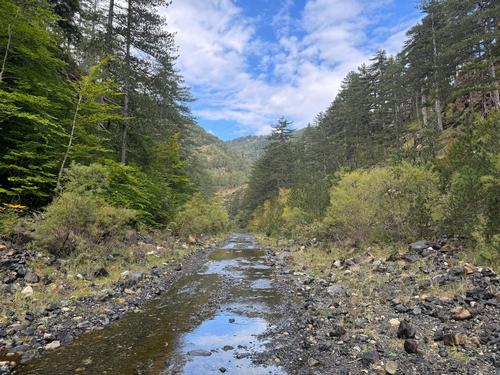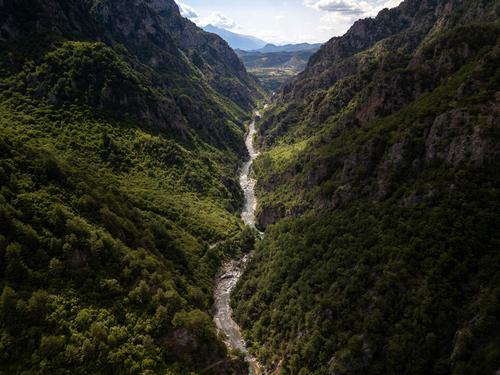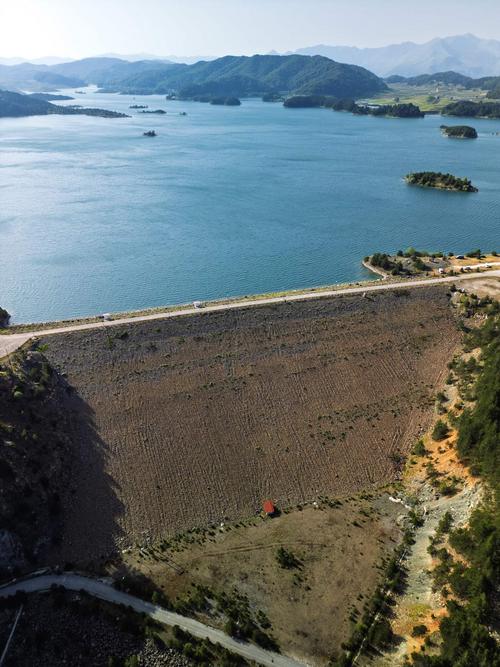The lack of required ecological flow from a hydropower dam in the Greek section of the Aoos/Vjosa River is endangering a unique and fragile ecosystem. A new scientific study underscores the urgent need to establish a minimum flow regime to restore the river’s ecological functions and safeguard its rich biodiversity.

The once free-flowing river has been reduced to a narrow stream just 1.3 meters wide due to lack of ecological flow from the Aoos Springs dam.
© Fanikos Sakellarakis | Medina
The Aoos/Vjosa above the bridge in Konitsa.
© Joshua D. Lim
The Aoos Springs dam has completely cut off water flow to the river's downstream section.
© Joshua D. LimAthens, Radolfzell, Vienna. A new scientific study, led by researchers from the University of Natural Resources and Life Sciences (BOKU) in Vienna and the Hellenic Centre for Marine Research (HCMR) in Athens, highlights severe ecological consequences due to the lack of ecological flow from the Aoos Springs dam. This absence is disrupting both the river’s biodiversity and its natural hydrological regime.
According to the EU Water Framework Directive, ecological flow is not simply a minimum water volume, but the amount of water necessary for downstream ecosystems to maintain their natural characteristics and carry out vital ecological functions. Under the provisions of both the EU Water Framework Directive (2000/60/EC) and the Habitats Directive (92/43/EEC), member states are required to ensure adequate hydrological flow to achieve "good ecological status" and to protect designated species and habitats—many of which depend directly on continuous river flow. Despite this, Greek legislation does not currently require the establishment of ecological flow for large hydroelectric dams.
The Aoos/Vjosa, one of Europe’s last wild rivers, stretches for 260 km from its source in Greece, flowing through the Northern Pindos National Park and thirteen Natura 2000 sites before crossing into Albania, where it forms the Vjosa Wild River National Park and eventually empties into the Adriatic Sea. It forms a vital ecological corridor and a transboundary ecosystem recognized under both European and national legislation. However, the construction of the Aoos Springs dam in 1987, part of a key hydroelectric infrastructure project and artificial reservoir, completely cut off water flow to the river’s downstream section, triggering a cascade of severe ecological impacts.
The study—published by Riverwatch, EuroNatur and MedINA as part of the international alliance Save the Blue Heart of Europe—highlights the urgent need to restore ecological flow at the Aoos Springs dam. Key findings include:
- With no ecological flow from the Aoos Springs dam, the once free-flowing river has been reduced to a narrow stream just 1.3 meters wide. This has triggered drastic hydromorphological changes and severely degraded the surrounding riparian ecosystem.
- The absence of ecological flow has caused drastic habitat loss and a significant decline in fish diversity and populations—particularly affecting species like the Balkan trout (Salmo farioides), which is protected under the EU Habitats Directive.
- These impacts are most critical during the dry summer months and extend into the Northern Pindos National Park and three Natura 2000 sites, raising urgent concerns under current climate crisis conditions.
The study underscores the urgent need to restore ecological flow to safeguard the river’s biodiversity. It recommends implementing both a year-round minimum flow and dynamic seasonal variations to support fish reproduction, sediment transport, and natural riverbed renewal.
"The Aoos is not just a river. It is a vital artery of life, connecting ecosystems, communities, and cultural heritage. Ensuring ecological flow must become a cornerstone of public policy for the region’s sustainable future", says Alexis Katsaros, Executive Director of MedINA.
Background information:
- The recommended ecological flow includes a permanent minimum of 0.37 m³/sec—reflecting the river’s average summer flow prior to dam construction—and a dynamic component equal to 20% of the average daily discharge, to mimic natural variability and meet seasonal ecological needs.
- The study "Ecological Flow Assessment for the Aoos River below the Aoos Springs Reservoir Dam", was financially supported by the Manfred-Hermsen-Stiftung.
- The Save the Blue Heart of Europe campaign is coordinated by German and Austrian NGOs EuroNatur and Riverwatch, in partnership with organisations from Balkan countries. The campaign aims to protect the region's precious rivers, which are under threat from almost 3,200 hydropower projects. It advocates against large dam projects, for example, that are carried out under the guise of "green energy production".
Press contact:
Anika Konsek – EuroNatur, email: anika.konsek(at)euronatur.org
Fanikos Sakellarakis – MedINA, email: fanikos(at)med-ina.org
Cornelia Wieser – Riverwatch, email: cornelia.wieser(at)riverwatch.eu


